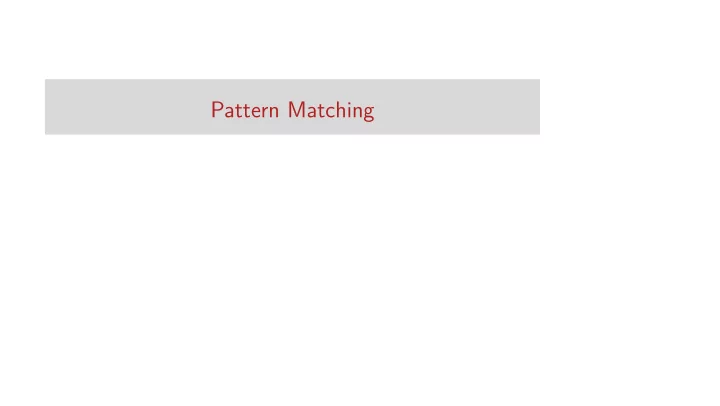

Pattern Matching
Reminder: Decomposition The task we are trying to solve is find a general and convenient way to access objects in a extensible class hierarchy. Attempts seen previously : touch all classes to add a new method. ▶ Classification and access methods : quadratic explosion ▶ Type tests and casts : unsafe, low-level ▶ Object-oriented decomposition : does not always work, need to
Solution 2: Functional Decomposition with Pattern Matching Observation: the sole purpose of test and accessor functions is to reverse the construction process: This situation is so common that many functional languages, Scala included, automate it. ▶ Which subclass was used? ▶ What were the arguments of the constructor?
Case Classes A case class definition is similar to a normal class definition, except that it is preceded by the modifier case . For example: trait Expr case class Number(n: Int) extends Expr case class Sum(e1: Expr, e2: Expr) extends Expr Like before, this defines a trait Expr , and two concrete subclasses Number and Sum .
Case Classes (2) It also implicitly defines companion objects with apply methods. object Number { def apply(n: Int) = new Number(n) } object Sum { def apply(e1: Expr, e2: Expr) = new Sum(e1, e2) } so you can write Number(1) instead of new Number(1) . However, these classes are now empty. So how can we access the members?
Pattern Matching Pattern matching is a generalization of switch from C/Java to class hierarchies. It’s expressed in Scala using the keyword match . Example def eval(e: Expr): Int = e match { case Number(n) => n case Sum(e1, e2) => eval(e1) + eval(e2) }
Match Syntax Rules: value of the selector. ▶ match is followed by a sequence of cases , pat => expr . ▶ Each case associates an expression expr with a pattern pat . ▶ A MatchError exception is thrown if no pattern matches the
Forms of Patterns Patterns are constructed from: Variables always begin with a lowercase letter. The same variable name can only appear once in a pattern. So, Sum(x, x) is not a legal pattern. Names of constants begin with a capital letter, with the exception of the reserved words null , true , false . ▶ constructors , e.g. Number , Sum , ▶ variables , e.g. n , e1 , e2 , ▶ wildcard patterns _ , ▶ constants , e.g. 1 , true .
Evaluating Match Expressions An expression of the form order in which they are written. The whole match expression is rewritten to the right-hand side of the first case where the pattern matches the selector e . References to pattern variables are replaced by the corresponding parts in the selector. e match { case p 1 = > e 1 ... case p n = > e n } matches the value of the selector e with the patterns p 1 , ..., p n in the
What Do Patterns Match? type C (or a subtype) that have been constructed with the variable to this value. sense of == ) ▶ A constructor pattern C ( p 1 , ..., p n ) matches all the values of arguments matching the patterns p 1 , ..., p n . ▶ A variable pattern x matches any value, and binds the name of ▶ A constant pattern c matches values that are equal to c (in the
Example Example eval(Sum(Number(1), Number(2))) Sum(Number(1), Number(2)) match { case Number(n) => n case Sum(e1, e2) => eval(e1) + eval(e2) } eval(Number(1)) + eval(Number(2)) → →
Example (2) Number(1) match { case Number(n) => n case Sum(e1, e2) => eval(e1) + eval(e2) } + eval(Number(2)) 1 + eval(Number(2)) 3 → → → →
Pattern Matching and Methods Of course, it’s also possible to define the evaluation function as a method of the base trait. Example trait Expr { def eval: Int = this match { case Number(n) => n case Sum(e1, e2) => e1.eval + e2.eval } }
Exercise Write a function show that uses pattern matching to return the representation of a given expressions as a string. def show(e: Expr): String = ???
Exercise (Optional, Harder) Add case classes Var for variables x and Prod for products x * y as discussed previously. Change your show function so that it also deals with products. Pay attention you get operator precedence right but to use as few parentheses as possible. Example Sum(Prod(2, Var(”x”)), Var(”y”)) should print as “ 2 * x + y ”. But Prod(Sum(2, Var(”x”)), Var(”y”)) should print as “ (2 + x) * y ”.
Recommend
More recommend